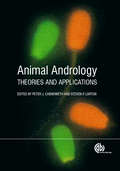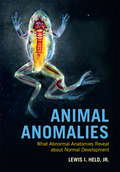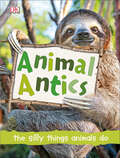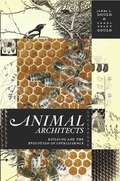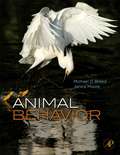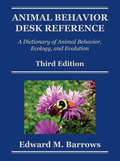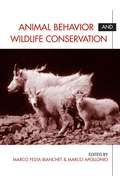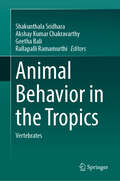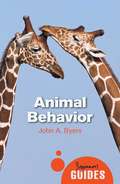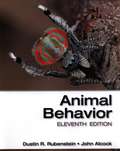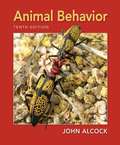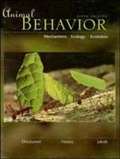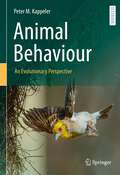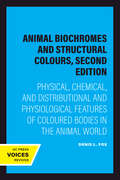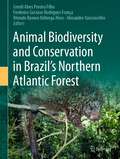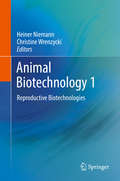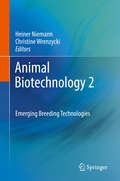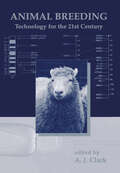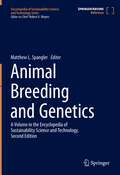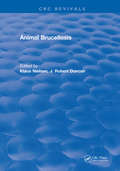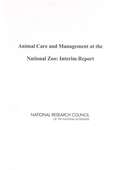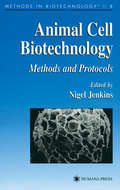- Table View
- List View
Animal Andrology: Theories and Applications
by William E William E Brian P Brian P Lefric Lefric Francoise J Francoise J Julie A Julie A Erdogan Erdogan Bart M Bart M Sema Sema Abdullah Abdullah Clifford F Clifford F William L William L M Margaret V Margaret V Linda Linda Swanand SwanandUnderstanding animal andrology is fundamental to optimising genetic breeding traits in domestic and wild animals. This book provides extensive coverage of male reproductive biology, discussing the essentials of sperm production, harvest and preservation before covering the applications to a range of animals including cattle, horses, pigs, small ruminants, camelids, cats and dogs, poultry and exotic species. It also examines the laboratory procedures that provide the basis of general fertility research.
Animal Anomalies: What Abnormal Anatomies Reveal about Normal Development
by Lewis I. Held, JrAmong the offspring of humans and other animals are occasional individuals that are malformed in whole or in part. The most grossly abnormal of these have been referred to from ancient times as monsters, because their birth was thought to foretell doom; the less severely affected are usually known as anomalies. This volume digs deeply into the cellular and molecular processes of embryonic development that go awry in such exceptional situations. It focuses on the physical mechanisms of how genes instruct cells to build anatomy, as well as the underlying forces of evolution that shaped these mechanisms over eons of geologic time. The narrative is framed in a historical perspective that should help students trying to make sense of these complex subjects. Each chapter is written in the style of a Sherlock Holmes story, starting with the clues and ending with a solution to the mystery.
Animal Antics
by DKHave you ever wondered how ants carry up to 50 times their body weight? Or why sloths move so slowly? Discover the answers to these questions and more as you laugh along at the hilarious pictures in this fun non-fiction book for kids.Animal Antics is jam-packed with funny photos of animals in action. Look out for goats popping up in unexpected places, zebras and chimpanzees grinning for the camera, and adorable chipmunks with bulging cheeks. Alongside high quality images, each page features mind-boggling facts about your favourite animals, including how they get around, what they like to eat, and how they stay cool or keep warm.Children will love this fresh glimpse into the lives of loads of weird and wonderful animals.
Animal Architects: Building and the Evolution of Intelligence
by James L. Gould Carol Grant GouldAnimal behavior has long been a battleground between the competing claims of nature and nurture, with the possible role of cognition in behavior as a recent addition to this debate. There is an untapped trove of behavioral data that can tell us a great deal about how the animals draw from these neural strategies: The structures animals build provide a superb window on the workings of the animal mind. Animal Architects examines animal architecture across a range of species, from those whose blueprints are largely innate (such as spiders and their webs) to those whose challenging structures seem to require intellectual insight, planning, and even aesthetics (such as bowerbirds’ nests, or beavers’ dams). Beginning with instinct and the simple homes of solitary insects, James and Carol Gould move on to conditioning; the "cognitive map” and how it evolved; and the role of planning and insight. Finally, they reflect on what animal building tells us about the nature of human intelligence-showing why humans, unlike many animals, need to build castles in the air.
Animal Behavior
by Michael Breed Janice MooreAnimal Behavior covers the broad sweep of animal behavior from its neurological underpinnings to the importance of behavior in conservation. The authors, Michael D. Breed and Janice Moore, bring almost 60 years of combined experience as university professors to this textbook, much of that teaching animal behavior. An entire chapter is devoted to the vibrant new field of behavior and conservation, including topics such as social behavior and the relationship between parasites, pathogens, and behavior. Thoughtful coverage has also been given to foraging behavior, mating and parenting behavior, anti-predator behavior and learning. This text addresses the physiological foundations of behavior in a way that is both accessible and inviting. Each chapter begins with learning objectives and concludes with thought-provoking questions. Additionally, special terms and definitions are highlighted throughout.
Animal Behavior Desk Reference: A Dictionary of Animal Behavior, Ecology, and Evolution, Third Edition
by Edward M. Barrows"Words are our tools, and, as a minimum, we should use clean tools. We should know what we mean and what we do not, and we must forearm ourselves against the traps that language sets us." -- The Need for Precise Terminology, Austin (1957, 7-8) It follows that, for effective and efficient communication, people should have, or at least understand, th
Animal Behavior and Wildlife Conservation
by Marco Apollonio Marco Festa-BianchetEfforts to conserve wildlife populations and preserve biological diversity are often hampered by an inadequate understanding of animal behavior. How do animals react to gaps in forested lands, or to sport hunters? Do individual differences--in age, sex, size, past experience--affect how an animal reacts to a given situation? Differences in individual behavior may determine the success or failure of a conservation initiative, yet they are rarely considered when strategies and policies are developed. Animal Behavior and Wildlife Conservation explores how knowledge of animal behavior may help increase the effectiveness of conservation programs. The book brings together conservation biologists, wildlife managers, and academics from around the world to examine the importance of general principles, the role played by specific characteristics of different species, and the importance of considering the behavior of individuals and the strategies they adopt to maximize fitness.Each chapter begins by looking at the theoretical foundations of a topic, and follows with an exploration of its practical implications. A concluding chapter considers possible future contributions of research in animal behavior to wildlife conservation.
Animal Behavior in the Tropics: Vertebrates
by Akshay Kumar Chakravarthy Shakunthala Sridhara Geetha Bali Rallapalli RamamurthiThis book discusses trends in animal behavior focusing specifically on vertebrates from the tropical region. It includes topics on a wide range of disciplines such as electrophysiology, molecular biology, reproductive physiology, foraging and feeding behavior, chemical ethology and ecology, in-situ and ex-situ conservation, circadian rhythms, climate change and several other related topics that are of high interest and utility. Tropical countries have a unique and diversified fauna across their different biogeographical habitats. This book covers numerous species of vertebrates from the tropical region and also discusses several case studies to provide detailed information about the recent trends in the animal behavior pattern. This book is useful for academicians, researchers, ethologists, wildlife specialists and practitioners. This book is also an interesting read for scholars, professors and policy makers involved in the field of zoology, naturalists and wildlife enthusiasts.
Animal Behavior: A Beginner's Guide (Beginner's Guides)
by John ByersWhy do birds have regional accents? Can horses learn math? What do animals without eyes see? Questions such as these have fascinated scientists and animal lovers alike long before ethology - the study of animal behavior - became recognized as a science in the 1970s. Now, as issues of conservation and welfare dominate the field, an understanding of how and why animals act the way they do has become even more critical.Communicating the passion of the scientists who have driven the discipline, John Byers draws together evolutionary theory, ecology, population biology, genetics, physiology, and anatomy to demonstrate the diversity involved when studying animals. By explaining the mechanisms and motivations behind a range of animal movements he illuminates key issues about our own behavior while equipping readers with the core knowledge and skills to further their own studies.
Animal Behavior: An Evolutionary Approach
by John Alcock Dustin RubenstienA comparative and integrative overview of how and why animals as diverse as insects and humans behave the way that they do, linking behaviors to the brain, genes, and hormones, as well as to the surrounding ecological and social environments.
Animal Behavior: An Evolutionary Approach
by John AlcockThe tenth edition features a major reorganisation, focusing first on the evolutionary basis of behavior followed by the underlying proximate mechanisms. Enduring features of previous editions also remain; the clear engaging writing style, the beautifully illustrated text with many new photographs and numerous references to new scientific articles.
Animal Behavior: Concepts, Methods, and Applications, Third Edition
by Shawn E. Nordell Thomas J. ValoneEmphasizes Concepts. Animal Behavior: Concepts, Methods, and Applications, Third Edition, uses broad organizing concepts to provide a framework for understanding the science of animal behavior. In an engaging, question-driven style, Shawn E. Nordell and Thomas J. Valone offer readers a clear learning progression for understanding and evaluating empirical research examples. Focuses On Methodology and The Process of Science. Featured studies illustrate each concept and emphasize the experimental designs and the hypothesis testing methods scientists use to address research questions. Highlights Real-World Applications. Concepts are related to real life to help students understand the broader significance of animal behavior research, including applications to human behavior and conservation.
Animal Behavior: Mechanisms, Ecology, Evolution
by Lee C. Drickamer Stephen H. Vessey Elizabeth JakobAnimal behavior is a broad discipline diverse perspectives, including anthropology, comparative psychology, ecology, ethology, physiology, and zoology.
Animal Behaviour: An Evolutionary Perspective
by Peter M. KappelerThis textbook presents all basic principles of animal behaviour in a clear and concise manner and illustrates them with up-to-date examples. Emphasis is placed on behavioural biology as an integrative discipline of organismic biology, focusing on the adaptive value of behaviours that facilitate resource access, predator avoidance and reproductive success and underlie parental care, all within a comprehensive presentation of social complexity. This new textbook provides a rich resource for students (and teachers) from a wide range of life science disciplines.
Animal Biochromes and Structural Colours, Second Edition: Physical, Chemical, and Distributional and Physiological Features of Coloured Bodies in the Animal World
by Denis L. FoxThis title is part of UC Press's Voices Revived program, which commemorates University of California Press’s mission to seek out and cultivate the brightest minds and give them voice, reach, and impact. Drawing on a backlist dating to 1893, Voices Revived makes high-quality, peer-reviewed scholarship accessible once again using print-on-demand technology. This title was originally published in 1976.This title is part of UC Press's Voices Revived program, which commemorates University of California Press’s mission to seek out and cultivate the brightest minds and give them voice, reach, and impact. Drawing on a backlist dating to 1893, Voices Revived</DIV
Animal Biodiversity and Conservation in Brazil's Northern Atlantic Forest
by Rômulo Romeu Nóbrega Alves Gentil Alves Pereira Filho Frederico Gustavo Rodrigues França Alexandre VasconcellosThis book describes the fauna of the Pernambuco Endemism Center in Brazil's Northern Atlantic Forest, an understudied global biodiversity hotspot. Through fifteen curated chapters, it provides the latest information about the fauna of the northern portion of the Atlantic Forest, gathering important information about the faunal composition of the region for the first time. The chapters address animal biodiversity including terrestrial and aquatic vertebrates (fish, amphibians, reptiles, birds, and mammals) and invertebrates (ants, butterflies, dung beetles, hervestmen, spiders, and termites). All chapters provide species lists, taxonomic aspects and richness analysis. Conservation of specific animal groups is also discussed. Finally, the book discusses human impacts on the forest and its biodiversity, emphasizing the need for conservation of this highly impacted ecosystem.
Animal Biotechnology 1: Reproductive Biotechnologies
by Heiner Niemann Christine WrenzyckiThis two-volume textbook provides a comprehensive overview on the broad field of Animal Biotechnology with a special focus on livestock reproduction and breeding. The reader will be introduced to a variety of state-of-the-art technologies and emerging genetic tools and their applications in animal production. Also, ethics and legal aspects of animal biotechnology will be discussed and new trends and developments in the field will be critically assessed. The two-volume work is a must-have for graduate students, advanced undergraduates and researchers in the field of veterinary medicine, genetics and animal biotechnology.This first volume mainly focuses on artificial insemination, embryo transfer technologies in diverse animal species and cryopreservation of oocytes and embryos.
Animal Biotechnology 2: Emerging Breeding Technologies
by Heiner Niemann Christine WrenzyckiThis two-volume textbook provides a comprehensive overview on the broad field of Animal Biotechnology with a special focus on livestock reproduction and breeding. The reader will be introduced to a variety of state-of-the-art technologies and emerging genetic tools and their applications in animal production. Also, ethics and legal aspects of animal biotechnology will be discussed and new trends and developments in the field will be critically assessed. The two-volume work is a must-have for graduate students, advanced undergraduates and researchers in the field of veterinary medicine, genetics and animal biotechnology.This second volume is dedicated to genetic tools in animal biotechnology such as somatic cloning, transgenic technologies and the application of stem cells in livestock breeding. Also, ethics and legal aspects are discussed.
Animal Breeding
by A.E. ClarkThis text part offers a review of the research and developing technologies in the expanding areas of genetics, embryology, and molecular biology from experts in the various fields. It includes sections covering manipulation of the embryo, and the mapping and engineering of the genome, as well as information on nuclear transfer and the development of xenotransplantation. Possibilities for future research and development are also considered.
Animal Breeding and Genetics (Encyclopedia of Sustainability Science and Technology Series)
by Matthew L. SpanglerThis newly updated and revised volume of the Encyclopedia of Sustainability Science and Technology (ESST) details the role of Animal Breeding and Genetics in the sustainability of animal agriculture. The volume covers scientific principles and applications includes the current science used to advance cattle, poultry, swine,sheep, and equine populations, as well as the future role of techniques such as gene editing. International leaders in the field explain foundational concepts such as heritability, the covariance between relatives, statistical approaches to predicting the genetic merit of individuals, and the development and advancement of molecular techniques to elucidate changes in the DNA sequence that underly phenotypic variation. The use of genetic-based tools to improve animal agriculture and meet consumer demands across species is treated in detail. Readers will gain an understanding of how global livestock producers have implemented advanced genetic selection tools and used them to improve reproduction, production, efficiency, health, and sustainability. The interactions of genetics and production environments, and the genetic components of the complex interactions among animals are also discussed. The future of Animal Breeding and Genetics, including the challenges and opportunities that exist in feeding a growing world population, are addressed.
Animal Brucellosis
by Klaus NielsenThis timely publication updates and standardizes currently used diagnostic procedures for this widespread, economically costly livestock disease. It includes state-of-the-art technology, now in limited use, which will replace the conventional methodology in the near future. The volume covers research done on improved diagnostic techniques, vaccines, taxonomy, epidemiology, pathology, and basic immunology. It is an important literature review for those more established in this field and serves as a guide to researchers or diagnosticians becoming involved with this disease.
Animal Camouflage
by Sami Merilaita Martin StevensIn the last decade, research on the previously dormant field of camouflage has advanced rapidly, with numerous studies challenging traditional concepts, investigating previously untested theories and incorporating a greater appreciation of the visual and cognitive systems of the observer. Using studies of both real animals and artificial systems, this book synthesises the current state of play in camouflage research and understanding. It introduces the different types of camouflage and how they work, including background matching, disruptive coloration and obliterative shading. It also demonstrates the methodologies used to study them and discusses how camouflage relates to other subjects, particularly with regard to what it can tell us about visual perception. The mixture of primary research and reviews shows students and researchers where the field currently stands and where exciting and important problems remain to be solved, illustrating how the study of camouflage is likely to progress in the future.
Animal Care and Management at the National Zoo: Final Report
by National Research Council of the National AcademiesThis report follows up on an interim report released in February 2004 that focused on immediate needs in the areas of animal care and management, recordkeeping, and pest control. The report finds that the zoo has made good-faith efforts to correct deficiencies noted in the interim report and has made some noticeable improvements in the past year in zoo operations and animal care. However, problems in areas such as staff training, workplace culture, and strategic planning still need to be addressed. Specifically, the report recommends that the zoo immediately develop and implement animal-care training programs to ensure that people who are directly responsible for the well-being of its animal collection are adequately prepared and competent. The report commends a zoo-initiated strategic planning process as a positive step, but recommends it contain a more detailed, comprehensive strategy of how it will meet short-term goals and that it should link plans to upgrade facilities with those to acquire animals. The zoo should also focus on improving communication among keepers, veterinarians, nutritionists, senior managers, and curators.
Animal Care and Management at the National Zoo: Interim Report
by National Research Council of the National AcademiesThis interim report assesses issues related to animal management, husbandry, health, and care at the Smithsonian Institution's National Zoological Park. The report finds that there are shortcomings in care and management that are threatening the well-being of the animal collection and identifies the "most pressing" issues that should be addressed.
Animal Cell Biotechnology: Methods and Protocols (Methods in Biotechnology #8)
by Nigel JenkinsScientists with long-refined expertise describe cutting-edge techniques for the production of therapeutic proteins and vaccines. Capturing the major advances that have occurred in both the science and the technology of these biopharmaceuticals, this important book covers the powerful new techniques used in genetically manipulating animal cells, optimizing their growth in defined media (particularly at large-scale), avoiding contamination, and in the harvesting and analysis of cell products. Topics include basic culture facilities and methods; molecular methods for gene transfection, cell immortalization and cell fusion; and techniques for the study of cell growth, viability, metabolism, and productivity. Animal Cell Biotechnology constitutes a comprehensive manual of state-of-the-art techniques for setting up a cell culture laboratory, maintaining cell lines, and optimizing critical parameters for cell culture.
